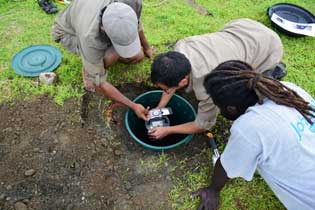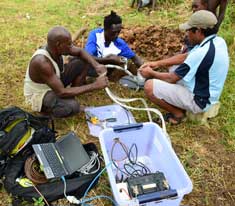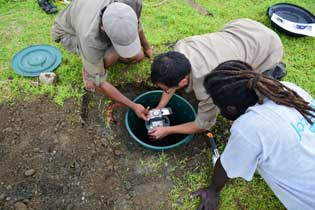 KINGSTON, R.I. – January 28, 2015 – A team of scientists led by a University of Rhode Island geologist is installing an array of seismometers in Papua New Guinea and the Solomon Islands in the western Pacific Ocean to study a massive underwater geological feature that could shed light on the evolution of Earth.
KINGSTON, R.I. – January 28, 2015 – A team of scientists led by a University of Rhode Island geologist is installing an array of seismometers in Papua New Guinea and the Solomon Islands in the western Pacific Ocean to study a massive underwater geological feature that could shed light on the evolution of Earth.
According to Brian Savage, URI associate professor of geosciences, the oceanic crust of the Ontong Java Plateau is about 35 kilometers thick, which is four or five times thicker than the crust in most other locations around the globe. He is seeking to learn how this 120-million-year-old crust was formed and if, as he believes, it was the result of a large thermal plume that rose from the Earth’s core.
 “We think there is something diagnostic in the mantle below the plateau that will tell us how it formed,” Savage said. “If we can figure that out, it will tell us a lot about how the Earth works on a large scale. Whatever happened there is way bigger than most of the geological processes we typically think about.”
“We think there is something diagnostic in the mantle below the plateau that will tell us how it formed,” Savage said. “If we can figure that out, it will tell us a lot about how the Earth works on a large scale. Whatever happened there is way bigger than most of the geological processes we typically think about.”
The seismometers that are being installed in the region by Savage’s collaborators from the United Kingdom will record the speed of seismic waves traveling through the earth as a result of earthquakes. From that data, he can infer the temperatures and rock composition deep below the surface to create an image of the structure below the plateau, somewhat like the way a medical CT scan creates an image of bone density.
“If it’s hotter and squishier in terms of its viscosity down there, then seismic waves travel through it slower,” Savage explained. “When it’s cold, it’s more stiff and the waves travel through it faster, for the most part. We’ll be able to determine the rock types based on the speed of the waves.”
The instruments will also record the seismic waves created by ambient noise like storms and crashing waves, providing additional data. “We don’t have to wait for earthquakes any more to collect our data,” Savage said. “We’ll have data from whatever noise we record, even if earthquakes suddenly stopped tomorrow.”
The URI professor has already conducted preliminary studies of the geology of the region and found seismic wave speeds that are faster than he would have expected.
“What we think we see is a mantle that is faster than normal mantle for the ocean, speeds that are more consistent with continental mantle than oceanic mantle,” he said. “My interpretation is that there is a lot of garnet there, a residual from a large melting event. It’s not a normal mantle plume, but a plume that’s odd in its composition.”
Following two years of data collection and analysis, Savage anticipates working with URI Professor Chris Kincaid and others to build a physical model of the plume structure to further investigate the formation of the Ontong Java Plateau.
Pictured above
Scientists collaborating with URI Associate Professor Brian Savage install seismometers in Papua New Guinea to learn about the formation of the Ontong Java Plateau. (Photos courtesy of Brian Savage)

